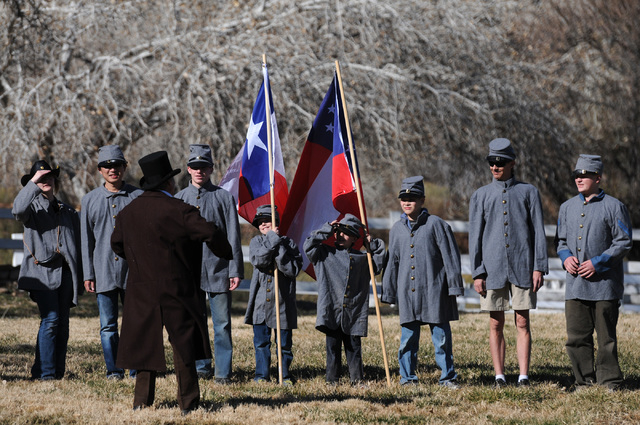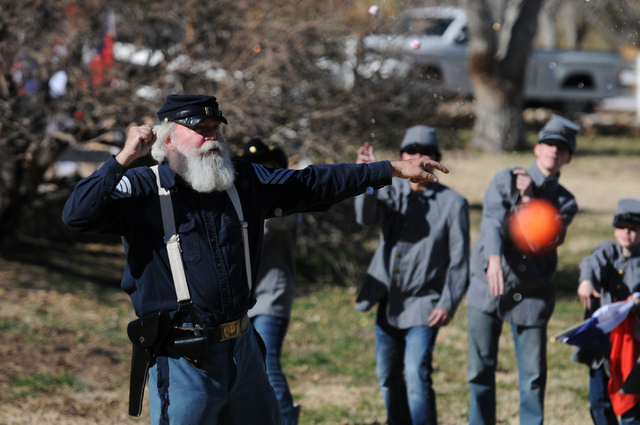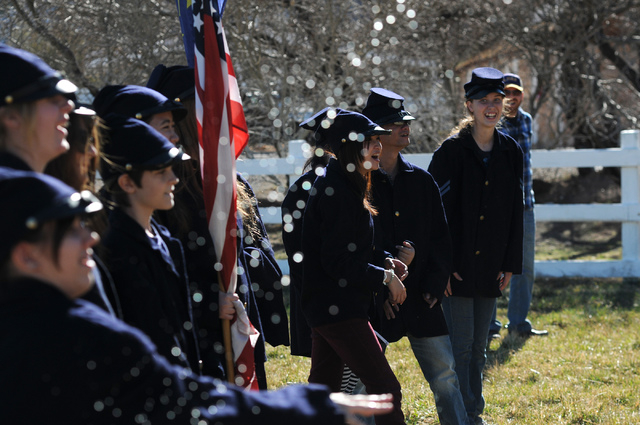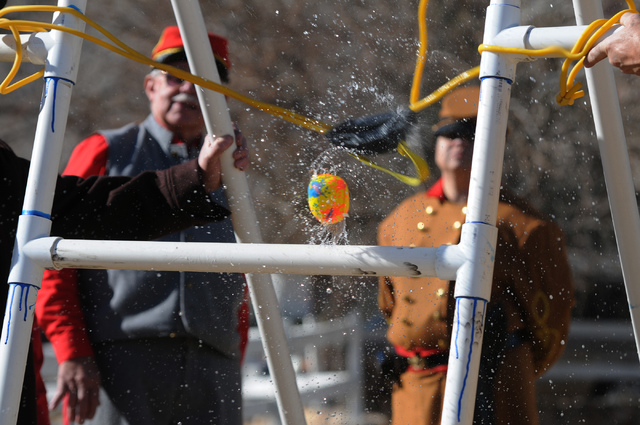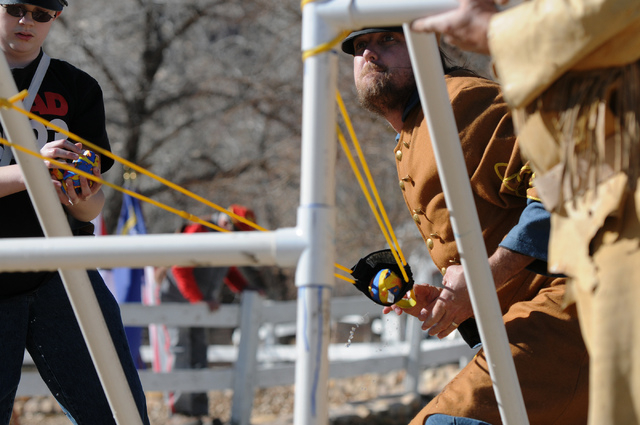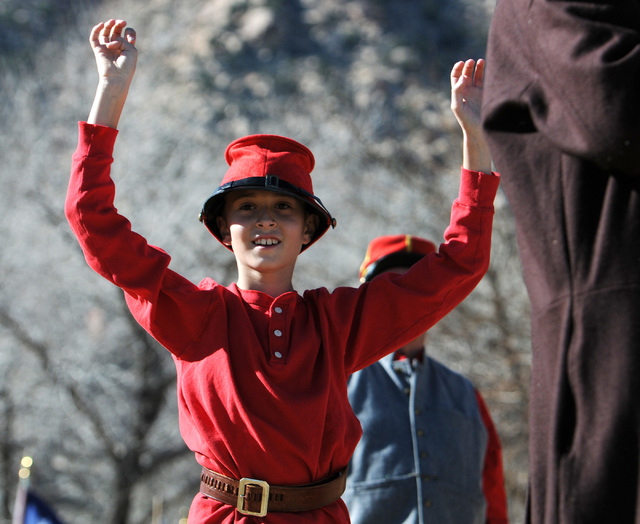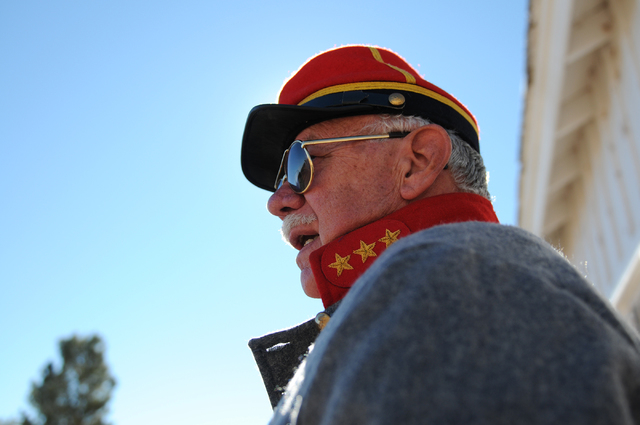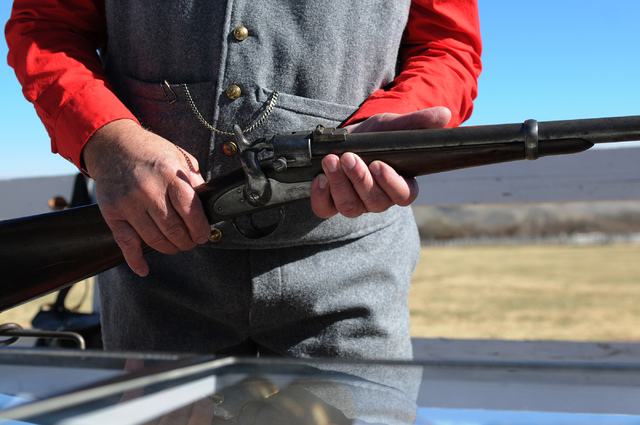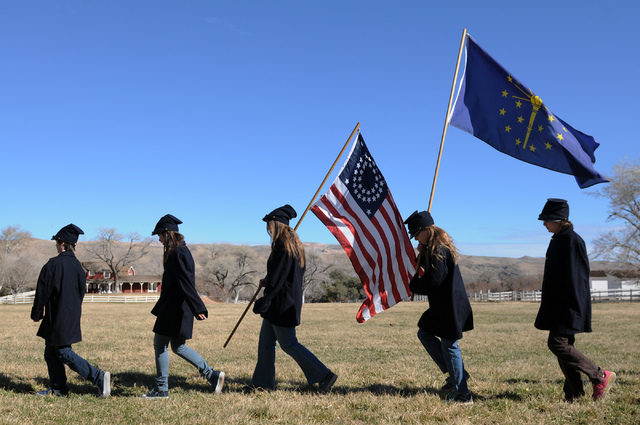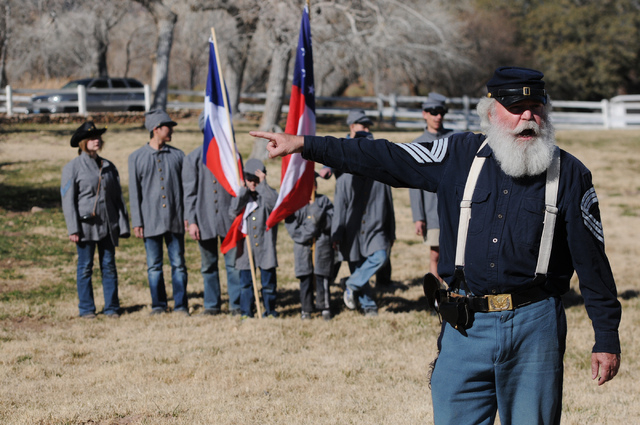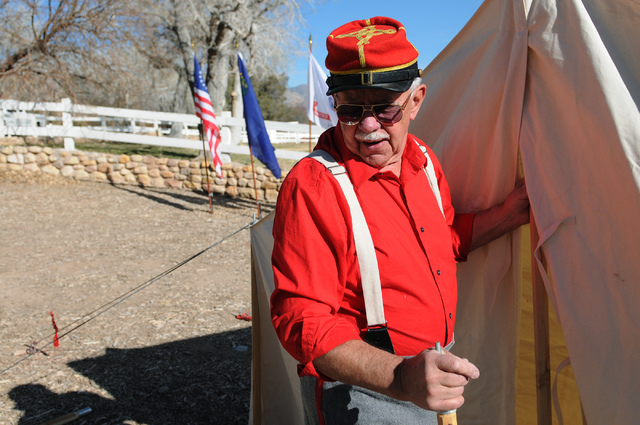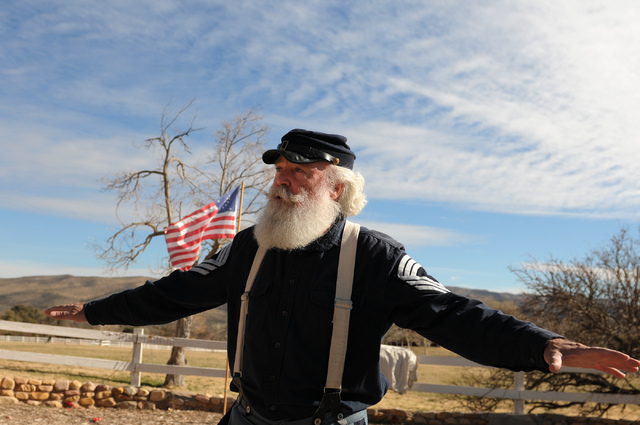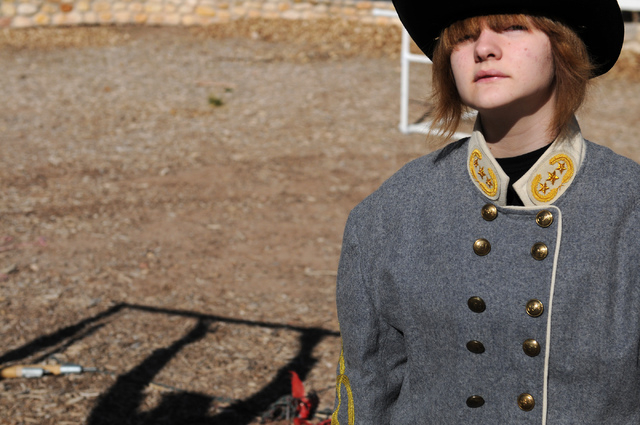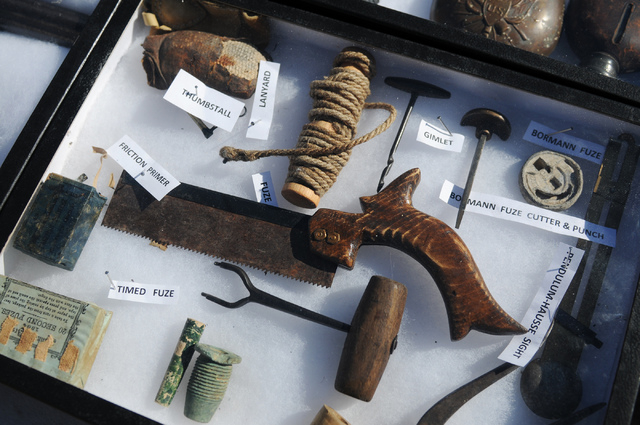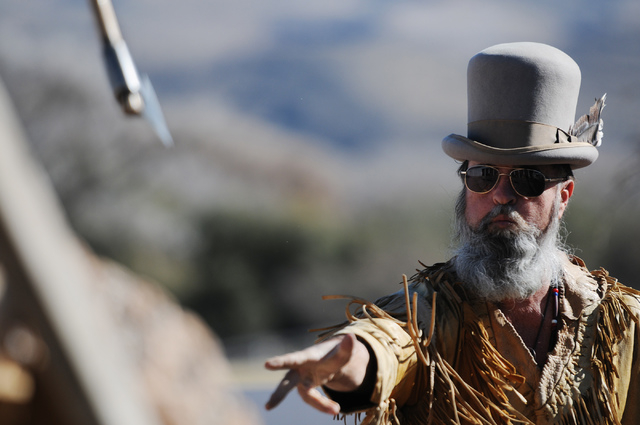Civil War left its mark on Nevada
Editor’s Note: Nevada 150 is a yearlong series highlighting the people, places and things that make up the history of the state.
Nevada may not seem a hotbed of Civil War history, but America’s deadliest conflict left indelible marks across the Silver State.
The timing of Nevada’s admittance into the Union, UNLV’s choice for a mascot and the celebrated friendship of two long-dead veterans buried in Las Vegas each bear signs, in their own way, of the legacy of the War Between the States.
Jim Edwards is one Southern Nevadan working to keep the memory alive. Clark County School District students and alumni may recognize him from campus battle re-enactments he has led in recent years.
On a warm Saturday in January, 17 youngsters joined him and other volunteers — members of Volunteers in Parks, the Nevada Civil War History Association or Veterans of Foreign Wars — at Spring Mountain Ranch State Park for similar hands-on learning.
“We are all out there to have fun and sneak a little history into the mix,” Edwards said.
Children donned replica blue and gray uniforms and filed into the makeshift camp, complete with an imitation medical tent, Union and Confederate flags, and stew cooking over an open fire, with a side dish of cold biscuits and jam.
“We don’t want to be Yankees,” said a boy’s voice from a line of kids waiting for coats and hats. “Us boys’ll take South, and you girls can take North.”
They formed regiments and practiced giving and following drill commands: “About, face. Right, face. Forward, MARCH!”
Four hours of preparation led to the finale: a mock battle, with water-soaked sponges hurtled through the air rather than bullets and cannon balls. Some flung them by hand, volley-style, while others used a 5-foot-tall slingshot to launch them toward temporary enemies. A hit was a casualty, and those unfortunate souls sat out till the next round.
But it wasn’t all fun without modern context. Edwards said the quick preparation signified just how the Civil War went down: In many cases, citizen soldiers left behind their everyday lives to take up arms and fight, with a quick turnaround.
Edwards also worked to dispel some common misinformation about a certain emblem: the First National flag of the Confederacy is the actual “Stars and Bars. ” With two red strips and one white, and white stars arranged in a circle inside a blue square, it’s not that different from the American flag.
“A lot of people think it’s that flag you see on the backs of trucks,” Edwards said, referring to the Confederate Battle Flag, which also became the controversial symbol of the Ku Klux Klan.
‘battle born’ state
Nevada’s “Battle Born” nickname goes back to its beginnings as a state: It was one of only two — the other being West Virginia — to enter the Union during the Civil War.
Nevada’s birthday is Oct. 31, 1864, hence the yearlong buildup for the sesquicentennial celebration this year.
The reason why Nevada became a state is another Civil War fact that gets misconstrued, according to historian Michael Green, who has written three books about the Civil War era.
The myth is that President Abraham Lincoln wanted Nevada’s gold and silver, Green said. But he already had the precious metals, because Nevada was a U.S. territory. And the fruits of labor from the Comstock Lode helped finance federal war efforts.
But in reality, Green said, Lincoln wanted Nevada statehood to help pass the 13th Amendment, which abolished slavery, and to ensure his re-election.
“We tend to forget that Honest Abe was also a politician, and he was worried about his chances, for good reason,” said Green, a College of Southern Nevada professor. “Every electoral vote counted, and he wanted the three from Nevada.”
But statehood didn’t come without a price, in one view. Part of the deal to accept Nevada was that the federal government got to keep most of the property, Green said.
That inheritance abides: More than 80 percent of acreage in Nevada’s boundaries is federal land, leading to complicated relationships with ranchers and the general public and a whole lot less acreage available for state property tax revenue.
Rebel symbolism
Nevada was a Union state, but Rebel symbolism certainly wasn’t lost here.
Look no further than the University of Nevada, Las Vegas, for now-toned-down throwbacks to Civil War imagery.
Students at what would become UNLV — but in the 1950s was a division of the University of Nevada located in Reno — named organizations and activities after relics of the Old South. Student government was known as Confederated Students of Nevada Southern, and social was Confederate Cotillion.
The first mascot was a cartoon wolf dressed in Confederate military garb named Beauregard, which happens to be the surname of a prominent Confederate general, Pierre Gustave Toutant Beauregard.
“They called themselves the Confederates because they saw themselves as being totally dependent on Reno, the north,” UNLV history professor Eugene Moehring said. “They wanted to be independent.”
But the 1960s and the civil rights movement brought changes. Las Vegas casinos that at one time allowed only black performers, not patrons, swung open their doors. High schools in Nevada and throughout the United States integrated. UNLV “evolved appropriately,” Moehring said, and maybe so much that the controversial past is forgotten in some ways.
“Most of these students have no idea about the history of this place anyway,” he said.
Second revolution
More than 600,000 Americans died fighting in the Civil War, mostly “back East,” as many Las Vegans refer to the Northeast, Midwest and South.
Being removed from the landscape of war — and the historical markers that remind you of it in places like Virginia, Pennsylvania or Georgia — can make it easy to feel disconnected.
But that disconnect loses a major piece of the American identity, according to author Tony Horwitz.
The former newspaper war correspondent has written about the lasting effects of the Civil War, going so far as to join re-enactors who starve themselves to get to the gaunt look of Confederate soldiers.
“It’s really the beginning of the modern era of the United States, truly a second American Revolution that transformed the nation as fundamentally as 1776 did,” Massachusetts-based Horwitz said by phone. “The fundamental issues at stake in the war — race in particular, but also states’ rights and the question, ‘Are we one nation?’ — remain very current and, in some ways, unresolved.”
In Las Vegas, there is a sign that shows there may have been some resolution among two who saw the conflict up-close and personal.
Two Civil War veterans who fought on opposite sides became friends after moving to Las Vegas when it was still a village.
William Keith, who served the Union, and Joseph Graham, the Confederacy, were both in their 20s during the war. Graham died at 78 in 1917. Keith lived to be 80.
Research in the 1990s by husband-and-wife Len and Em Becker show Keith made it his later life’s goal to ensure he and Graham stuck together after they both left the planet.
He bought two plots in Woodlawn Cemetery, at the intersection of what is now Las Vegas Boulevard and Owens Avenue, and their bodies rest there, side-by-side.
Keith’s obituary reads: “The lowering of his lifeless body into the grave close beside the one friend who was most dear during the sunset days of life, marked the close of one chapter in a story of a friendship and the beginning of yet another chapter.”
The Daughters of the Union Veterans, in which Em Becker was an officer in the Las Vegas chapter, placed a marker on the graves in 1997.
Len Becker is a Civil War buff who has a replica musket and actual bullets bought or found on family property. But he believes all Americans, even those who aren’t collectors and regardless of geography, should learn lessons from the nation’s greatest conflict.
“There’s more history here than you think,” Becker said. “There’s that old cliché that if we don’t know our history we’re bound to repeat it. We don’t want that.”
Contact reporter Adam Kealoha Causey at acausey@reviewjournal.com or 702-383-0401. Follow on Twitter @akcausey.




